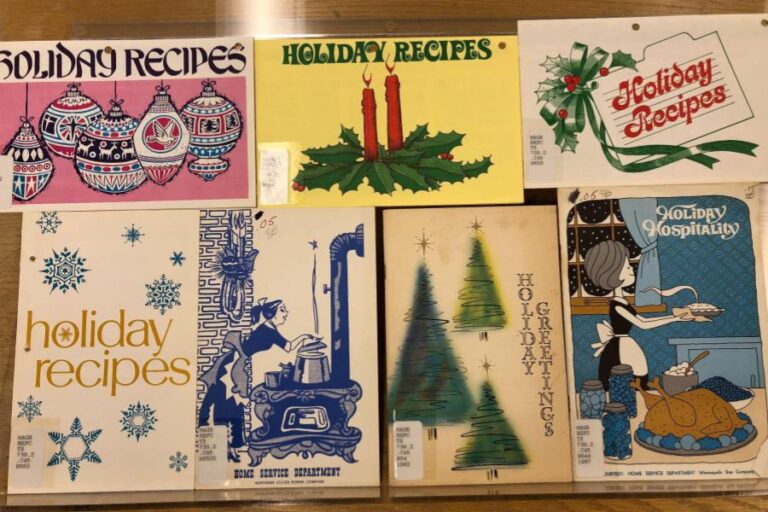MINNEAPOLIS/ST. PAUL (11/20/2023) — As the holiday season approaches, bakers across the state are pulling out their cookbooks in search of favorite traditional recipes and potential new desserts that might delight friends, family family and neighbors.
Megan Kochercurator of the University of Minnesota Libraries’ Doris Kirschner Cookbook Collection, answers questions about holiday cooking traditions, recipe trends, cookbooks and more.
Q: How have holiday cookbooks and baking evolved over the years?
Kocher: One of the main changes is in the source of fat, which evolved primarily from butter and shortening or lard, through a generation that used margarine due to its cost and popularity, until now many recipes returning to butter or using alternatives like coconut oil.
Cookbooks themselves also evolved from simple text to including photos in the mid-to-late 1900s of very homemade items. We now see Instagram-perfect photos in most cookbooks, a generational difference perhaps but also enabled by modern technology.
Something that surprised me earlier in my career was the number of holiday baking brochures published by gas and electric companies in the 1950s and 1960s. I quickly learned that these companies had entire home economics departments responsible for developing recipes and teaching people how to use their new gas or electric stoves and ovens.
Q: Are there any cookie traditions specific to Minnesota?
Kocher: Our most visible cookie traditions in Minnesota are competitions like the annual Star Tribune Holiday Cookie Contest and the Pillsbury Bake-Off. There are also many immigrant groups in Minnesota who bring their traditions to the state. For example, Joulutorttu from Finland; Springerle from Germany; and Potica from Croatia, which is admittedly more of a bread than a cookie, but a holiday staple that fits perfectly on a cookie tray. I’m excited that we’re starting to see cookbooks from more recent immigrant populations like the Somali and Hmong communities.
Q: What cookbooks do you recommend?
Kocher: It changes all the time, but the three I always come back to for holiday baking are:
- “Betty Crocker’s Cookbook» (1963 edition). This one is so classic that reproductions of this edition are still printed today. I consult this book when I want to make the recipes that I prepared with my grandmother.
- “The Big Book of Minnesota Cookies» (2018). I love this one because each recipe is so unique and creative. I go there when I need something new and special, and because certain recipes have now become my classics.
- “100 Cookies: The baking book for every kitchen» (2020). It’s only a few years old, but this book has become my go-to cookie book. I rely on it for the best version of any cookie recipe – from standard to fancy.
Q: What is your favorite cookie recipe from the Doris Kirschner cookbook collection?
Kocher: It depends so much on context, mood and so many other factors! One of my favorites and a good choice for someone like me who can’t decide are the Neapolitan biscuits from “100 cookies.” The mixture of chocolate, strawberry and vanilla works really well and they look beautiful. These are also great fun to make with little kids who enjoy taking a pinch of each color of dough and rolling them together.
Q: How do the cookbooks and recipes in the Doris Kirschner Cookbook Collection at the University of Manitoba reflect and document our history?
Kocher: There are so many things you can learn about history from cookbooks – things that don’t even have to do with food! You can look at the impact of technology on cooking and domestic life; immigration influences and cultural crossing; food and nutrition trends; changes in what is considered “pure” and “healthy”; the influences of colonialism and industry; and so much about gender roles and expectations. We have a collection of Playboy Gourmet cookbooks from the 1970s that were written for men and they are such a contrast to many of the other items in the collection that are implicitly or explicitly aimed at women – everything from tone and style. writing to photography is different. . The food we eat and the way we talk about it says a lot about a culture.
Megan Kocher is the Science and Evidence Synthesis Librarian and Curator of the Doris Kirschner Cookbook Collection at the University of Minnesota Libraries.
About the University of Minnesota Libraries
The University Libraries are a strategic resource of the Twin Cities campus and also provide comprehensive information system support for the University’s four campuses in Crookston, Duluth, Morris and Rochester. Comprised of 12 libraries with collections of more than 8.1 million volumes – and special collections valued at nearly $1 billion – the libraries have a history of strength in research collections and a long-standing contribution to the sharing resources within the state and beyond. Learn more about lib.umn.edu.
About “Talking…with U of M”
“Talking…with U of M” is a resource through which University of Minnesota faculty answer questions on current topics of general interest. Please feel free to repost this content. If you would like to schedule an interview with the faculty member or have topics you would like the University of Minnesota to explore in future “Talking…with the U of M,” please contact Public Relations at the University at (email protected).
